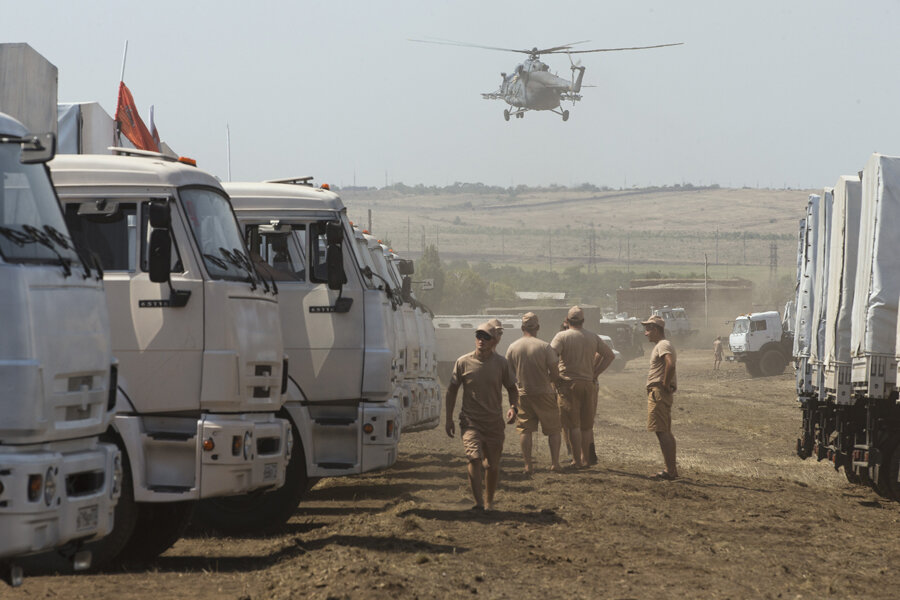Trojan horse? Russia aid convoy rattles nerves as it rumbles toward Ukraine
A Russian convoy of over 200 trucks allegedly carrying humanitarian aid to conflict-ridden eastern Ukraine is moving towards a rebel-controlled checkpoint creating an international guessing game and raising the prospect of an all out war.
Earlier this week Russia announced that it had come to an agreement with Ukraine and the International Committee of the Red Cross (ICRC) to deliver much needed humanitarian aid to the war-torn region of eastern Ukraine. But as the Russian trucks set out, the Ukrainian government said it would not let any of them cross onto its territory and the ICRC said it did not know the route Russian trucks were planning to take.
International leaders, including European Union Commission President Jose Manuel Barroso, issued stern warnings against using a humanitarian mission as a pretext for military intervention.
The Associated Press is reporting that the convoy is again on the move after stopping Tuesday evening, but instead of heading to Kharkiv, an area under control by Ukraine where supplies could have been off loaded and inspected by Ukrainian authorities and the ICRC, it appears to be heading to a rebel-controlled border crossing in the Luhansk region.
The mission has raised multiple questions:
Why has there been so much conflicting information about the convoy?
The Ukrainian government fears the trucks could be Trojan horses entering under the guise of aid – only to start an invasion. Russian President Vladimir Putin’s pledge to protect all Russian speakers, wherever they may live, has raised doubts over whether this really is a humanitarian mission.
The lack of information has thrust the ICRC into an uncomfortable position with the need to get aid to eastern Ukrainians but not knowing what Russia is planning. This has created worries that any move made by the ICRC could result in serious political implications.
“Putin practices the old KGB technique of maskirovka, masking and deception, in everything he does in this conflict,” Kimberly Marten, a professor at Barnard College and Columbia University, told the Monitor via email. “His goal is to keep people guessing, to create disunity among the Western community, and to buy time before deciding on his next move.”
An ICRC spokeswoman today said she could not confirm the convoy’s route: “The plans keep changing, the discussions are going ahead and we will not confirm for sure until we know an agreement has been reached. The practical details still have to be clarified between the two sides.”
Journalists on the ground have been trying to establish what is inside the trucks and where they are heading.
It remains unclear if all of the trucks are in fact carrying humanitarian aid:
Why have both sides waited until now to deliver aid?
There is no doubt that humanitarian aid is needed, with the United Nations reporting that the death toll in eastern Ukraine has now reached 2,086. The Ukrainian government today sent its own convoy of 75 trucks carrying 800 tons of aid for Luhansk, where many residents have faced shortages of food, water, and electricity as Ukrainian forces continue to battle rebels.
“I think there are capacity issues on the Ukrainian side,” says Andrew Weiss, vice president for studies at the Carnegie Endowment and former Russia and Ukraine expert on National Security Council under President Clinton. “Kiev’s ability to actually do things that have a material impact in Dontesk or Luhansk oblast have been circumscribed for months.”
With an economy in poor condition, this marks the first time Ukraine has had to fight a war in its modern history and deal with a large flow of internally displaced individuals.
Ms. Marten argues that it is not “surprising that they [the Ukrainian] are scrambling to create a coherent strategy.”
It remains unclear why Russia has chosen this moment to trumpet a humanitarian mission. Mr. Weiss notes there is no track record of trust between the two sides and Russia may be trying to score some points even though they have helped create the current situation.
How does this situation play out?
At this point, it’s hard to tell. The past nine months in Ukraine have been an unpredictable ride, from the start of protests on Kiev’s Maidan Nezalezhnosti in November to the ouster of ex-President Viktor Yanukovych in February to the Russian annexation of Crimea in March. Now the embattled country is facing a difficult fight against pro-Russian rebels who Kiev says have been well equipped by Russia.
As Ukrainian investigative journalist Sergii Leshchenko wrote in a column in Ukrainian Pravda, the convoy could well be a PR stunt by Putin aimed at the Russian public. However, it has managed to frighten and anger Ukrainians.
Like a real KGB agent, Putin created a new ‘wiring’ on an international scale, trying to deflect attention from topics unfavorable to him -- in Russia (level three international sanctions, food restrictions, Wi-Fi log-in with passports), and in the world (the downed aircraft). And it’s worked for him.
Mr. Weiss admits it’s impossible to predict what might happen at this point.
“If the Russians wanted to create a crisis and rush through the border they would not have waited,” he says. “They don’t do anything by accident. They have a purpose here…. They seem to want to have a debate on the humanitarian situation in the east and whether the Russians can help.”
Marten agrees saying it’s difficult to determine what Putin is trying to accomplish: “Who knows? That’s his point!”









